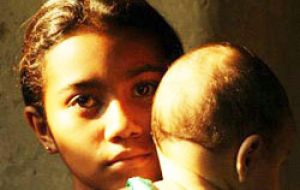MercoPress. South Atlantic News Agency
Almost 30% of teenagers (15 to 19) are mothers in Latin America
 Early maternity in Latin America and the Caribbean means 17.5 % of all infants are born to adolescents, a higher rate than the global average (11.2 %).
Early maternity in Latin America and the Caribbean means 17.5 % of all infants are born to adolescents, a higher rate than the global average (11.2 %).  Countries with the greatest maternity rates in women from 15 to 19 years of age are Nicaragua (19.9 %), the Dominican Republic (19.7%) and Ecuador (17.0%),
Countries with the greatest maternity rates in women from 15 to 19 years of age are Nicaragua (19.9 %), the Dominican Republic (19.7%) and Ecuador (17.0%),  Meanwhile, the number of children that women have throughout their lifetime (reproductive intensity) has fallen among all social groups
Meanwhile, the number of children that women have throughout their lifetime (reproductive intensity) has fallen among all social groups Nearly 30 % of young women in Latin America are mothers before they reach 20 years and the majority of them are underprivileged, which fosters the reproduction of poverty, hinders women's autonomy and their life projects, and underscores the need for public sex education and reproductive health services.
The paper “Reproduction in adolescence and its inequalities in Latin America” published by the Economic Commission for Latin America and the Caribbean, Eclac, indicates that teenage maternity rate, which shows the number of mothers 15 to 19 years old in the region declined between 2000 and 2010 after having increased in nineties according to the 1990 and 2000 censuses.
The proportion of 19 and 20 year olds in Latin America who were already mothers fell to about 28 % in 2010 from 32 % in 2000, which is similar to the level seen in 1990 (29 %).
Looking at the figures for teenager women between 15 and 19 years of age, which includes youth who have not lived through their entire adolescence, the percentage fell to 12.5 % in 2010 from 14.0 % in 2000. Nonetheless, in the first decade of this century the decline in teenage maternity was much smaller than that of total fertility and it did not counteract the increase from the 1990s, which means that this indicator is currently almost the same as it was 20 years ago.
Countries with the greatest maternity rates in women from 15 to 19 years of age are Nicaragua (19.9 %), the Dominican Republic (19.7%) and Ecuador (17.0%), while the lowest levels are seen in Uruguay (9.5%), Costa Rica (11.1%) and Peru (11.5%). All the countries have rates that are far above those seen in Western Europe, where adolescent maternity is around 2 %.
In addition, for the first time indicators are being released on maternity among girls below 15 years of age. Although the levels do not exceed 0.5 %, it is worrisome that this trend is on the rise because of the extreme vulnerability of such young mothers.
Meanwhile, the number of children that women have throughout their lifetime (reproductive intensity) has fallen among all social groups, but the age at which they have their first child (the reproductive calendar) continues to be quite early, especially in lower socioeconomic strata, which contributes to the intergenerational reproduction of poverty.
This early start to maternity is reflected in the fact that nearly 17.5 % of all infants in Latin America and the Caribbean are born to adolescents, a rate that is higher than that of Sub-Saharan Africa (15 %) and the global average (11.2 %).
In seven countries with available data, the number of mothers between 15 and 19 years of age in the lowest socioeconomic quintile is between three and four times greater than that of the highest quintile.
Another line of research indicates that in seven countries under analysis, more than half of the adolescents with low schooling levels are adolescent mothers. Meanwhile, the maternity rate among indigenous adolescents is higher than that of non-indigenous youth.
Regarding the adolescent fertility rate, which is the traditional indicator for comparing adolescents and is included in target 5.B of the Millennium Development Goals (MDGs), Latin America and the Caribbean registers 68 births among mothers 15 to 19 years old for every 1,000 women of the same age, a rate only surpassed in Sub-Saharan Africa, with 109 out of every 1,000, according to figures from 2010.
The study concludes that public policies in this area, as the Montevideo Consensu on Population and Development contends, should include comprehensive sex education, counseling for young women to exercise their rights and make informed decisions, and access to sexual and reproductive health services that include the provision of birth-control methods.




Top Comments
Disclaimer & comment rules-

-

-

Read all commentsThese girls are of course the children of “poor people” aka lazy buggers who did not teach their children how to avoid the errors they themselves made.
Nov 15th, 2014 - 11:07 am 0It is a self-fulfilling prophesy.
In Uruguay ‘No Money Pepe’ would be paying them out of the pockets of the people who do work for a living and then he wonders why things are not improving, other than they now have a new LED TV to watch in their hovel.
Neither of these two girls look happy, do they? They’ve had their fun and this is the result: they have ruined any chance they may have had to get out of their hovels and make a good life for themselves.
@1. Fun? Or food? Just how many hookers do argies demand? Ban argies from Uruguay for a year. See what happens!
Nov 15th, 2014 - 11:43 am 0The Catholic Church is responsible for this, (antiabortion/anti-contraception), that and lack of education by the governments.
Nov 15th, 2014 - 12:07 pm 0Poverty is also cause. When people are tired and desperate they seek comfort and solace in one another, any sort of joy and companionship, which then leads to this outcome.
Government mismanagement of the economy leads to poverty of the population.
Which increases the number of mouths to feed.
A vicious circle.
Let us be honest. You can not legislate aginst people having intercourse. You can educate them to do it safely, responsibly and provide free contraception. If the political will is there. Also the people need to be educated about the prevalent religous dogma so they can think for themselves.
Commenting for this story is now closed.
If you have a Facebook account, become a fan and comment on our Facebook Page!